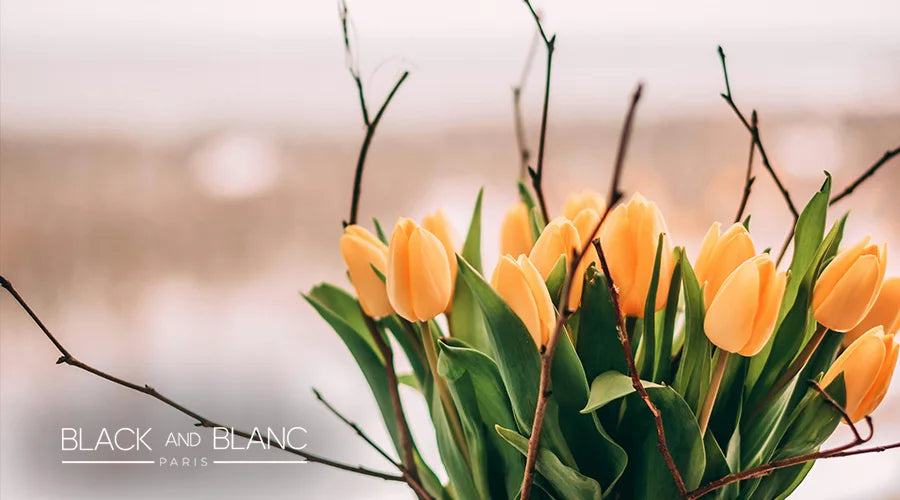The tulip is globally admired for its striking, simple beauty. Beyond outward looks, it conveys deep symbolism. Exploring its rich cultural history and each hue's meaning reveals layers within these vibrant blooms.
This article explores tulip flower meanings and symbolism across cultures and contexts.
Tulip Flowers and Their Meaning
| Tulip Color | Meaning and Symbolism |
| Red Tulips | Deep, passionate love, romantic love, belief in true love |
| Yellow Tulips | Cheerfulness, sunshine, hope, happiness |
| White Tulips | Purity, forgiveness, peace, new beginnings |
| Pink Tulips | Affection, caring, good wishes, happiness |
| Purple Tulips | Royalty, elegance, admiration |
| Orange Tulips | Understanding, appreciation, enthusiasm |
The History Behind Tulips

As one of the world's most recognizable flowers, the simple yet lovely tulip can be found in many homes and gardens. Striking a perfect balance of size, color, and form, the tulip is not too large, small, or vivid. With a rich history and symbolism, it's perfect for many occasions.
Most believe tulips originated in the Netherlands due to their iconic status there. However, they actually came from Central Asia as wildflowers. Turks first cultivated tulips around 1000 AD, and their name was derived from the Turkish word for turban due to similarities in bloom.
Europeans discovered tulips in the 16th century through botanist Carolus Clusius. By the 17th century, Dutch popularity soared. Tulipmania caused flower prices to skyrocket, crashing markets.
In the early 18th century, tulips still stormed the world. Turkey held impressive annual festivals, now exhibiting colors, and blanketing fields during Dutch springtime. Once illegal to buy/sell outside capitals, tulips represent today's most popular flowers.
Tulip's Meaning and Symbolism
Tulips have long held significance across cultures. Ancient Persians revered their beauty as divine. In Turkey, tulips starred in festivals and were once banned from sale outside the capital. Flowers effectively express feelings, each with distinctive meanings. Common tulip meanings include:

- Deep Love: The most recognized meaning of tulips is perfect, unconditional love. As a classic flower beloved for centuries, tulips represent love—ideal for those with deep feelings for partners, children, parents, or siblings.
- Rebirth: Since tulips bloom at spring's start, they also signify rebirth. If someone's experiencing changes, adventures, challenges, or new additions, their lovely bouquet could provide warmth.
- Charity: Since Victorian times, tulips have symbolized charity. With their cheerful spirit and new season/beginning representation, charities still employ tulips as emblems.
Like many flowers, tulip colors impact meaning. Knowing floral meanings, especially when gifting, helps convey the right message.
Red tulip flower meaning

Red, the most iconic tulip, symbolizes deep passion and romance. Given to convey feelings of lasting love, red tulips have become lifelong love flower tokens. In Persian legends, red tulips symbolize the blood of the heartbroken Prince Farhad, becoming a representation of perfect, eternal love.
Yellow tulip flower meaning

Yellow's cheer signifies happiness, hope, and brightening spirits. They were given to friends as signs of sunshine and smiles. Victorians saw yellow as standing for smiles radiating sunshine, boosting their popularity.
White tulip flower meaning

White tulips, with their pure, unmarked petals, symbolize purity, forgiveness, and fresh starts. They are often used in religious rites and funerals. Folklore claims dreaming of white tulips portends a new phase or life chapter.
Pink tulip flower meaning

Soft and feminine, pink tulips signify affection, care, and good wishes. They are often given as gifts for special occasions or to express gratitude.
In many cultures, pink tulips represent happiness and joy, making them a popular choice for celebratory events.
purple tulips meaning

With their rich, regal hue, purple tulips symbolize royalty, elegance, and admiration. They are associated with luxury and can represent appreciation or praise. In 16th century England, Queen Elizabeth I prohibited anyone besides royals from wearing purple, strengthening its ties to nobility.
Blue tulip flower meaning
Representing tranquility, serenity, and uniqueness, the rare blue tulip conveys a sense of peace and individuality.
peach tulip flower meaning
With their warm, soft hues, peach tulips symbolize warmth, sincerity, and gratitude, making them thoughtful for conveying appreciation.
golden tulip flower meaning
Bright and radiant golden tulips represent happiness, prosperity, and new beginnings, and they are famous for celebrations and well-wishes.
violet tulip flower meaning
With deep, rich hues, violet tulips symbolize spirituality, creativity, and imagination, inspiring contemplation.
black tulip flower meaning
While not entirely black, these deep purple tulips with near-black petals represent power, mystery, and the unknown, adding an air of intrigue to any floral arrangement.
The Perfect Lover Myth
An enduring Persian story tells of Prince Farhad, who loved Shirin deeply. Fate struck when Farhad falsely believed that she had died. Overcome with grief, he rode his horse off a cliff. It's said the first red tulips grew from his spilled blood.
This tragic tale shaped the red tulip as a token of ideal, eternal love - symbolizing Farhad's unending devotion to Shirin. The legend shows the tulip's profound link to love, passion, and the indomitable human heart.

With over 3,000 varieties, tulips dazzle in diverse forms, sizes, and hues. Popular kinds:
- Early Tulips: Simple cup-shaped blooms that herald the arrival of spring.
- Triumph Tulips: Sturdy and vibrant, ideal for borders and pots.
- Darwin Hybrid Tulips: Classic, large blooms with bold colors and long-lasting displays.
- Parrot Tulips: Unique petals with fringed edges resembling a parrot's feathers.
- Fringed Tulips: Delicate flowers with ruffled, fringed petals that add elegance to gardens and bouquets.
When Do Tulips Bloom?
Tulips are some of the first blooms of spring, with seasons ranging by variety and climate. Early types may flower from March through April, while later selections can continue into May or June in certain areas.
Do Tulips Come Back Every Year?
Yes, tulips are perennials, blooming annually with care. Supply well-draining soil and copious sun, and let leaves fade naturally after flowering. This natural process saves energy for next year's growth.
How Long Do Cut Tulips Last?
With care like fresh water and avoiding heat/drafts, cut tulips may grace you a week plus. Snip stems are at an angle to uptake water well and are often changed, per instructions in our complete tulip guide.
Fun Facts About Tulips

- Tulip buds form nearly symmetrically, counted among nature's finest designs.
- Representing enduring commitment, tulips signify an 11th wedding anniversary.
- Petals may replace onions in recipes or make wine, which is considered edible.
- At "Tulip Mania's" peak, rare bulbs are worth more than gold or diamonds.
- Over 150 species exist worldwide, with registered varieties exceeding 3,000.
- The world's tallest tulip stood proud at 28 inches.
- Cut blooms continue facing the sun for energy for days in vases.
- According to floral language, a fallen tulip denotes a lost or careless love.
- Their splendid colors result from selectively reflecting light's wavelengths.
Final Words
Beyond outward beauty, the tulip signifies deep heritage in tales, traditions, and symbolism. Passionate red speaks of undying love, while royal purple conveys elegance. As tokens of affection, commemoration, or fresh starts, tulips flexibly share abundant tales through vivid colors and captivation. As their splendor astounds you, recall the stories ingrained in their legacy - enriching admiration for nature's marvels.
Tulip Flower Meaning and Symbolism FAQs
What is the symbolism behind the red tulip?
According to Persian lore, red tulips emerged from a prince's spilled blood, standing for undying love. This deep crimson conveys passionate affection.
What do yellow tulips represent?
Yellow symbolizes cheer, sunshine, and friendship, and it brightens spirits as tokens of those feelings.
What is the meaning behind white tulips?
Purity, forgiveness, and fresh starts - at religious ceremonies and funerals, white brings reassurance of new beginnings.
What do pink tulips signify?
With sentiments of caring, pink tulips convey well-wishes, happiness, and gratitude appropriately for any occasion.
What is the significance of purple tulips?
Purple symbolizes luxury, admiration, and elegance as a refined token of high regard.














